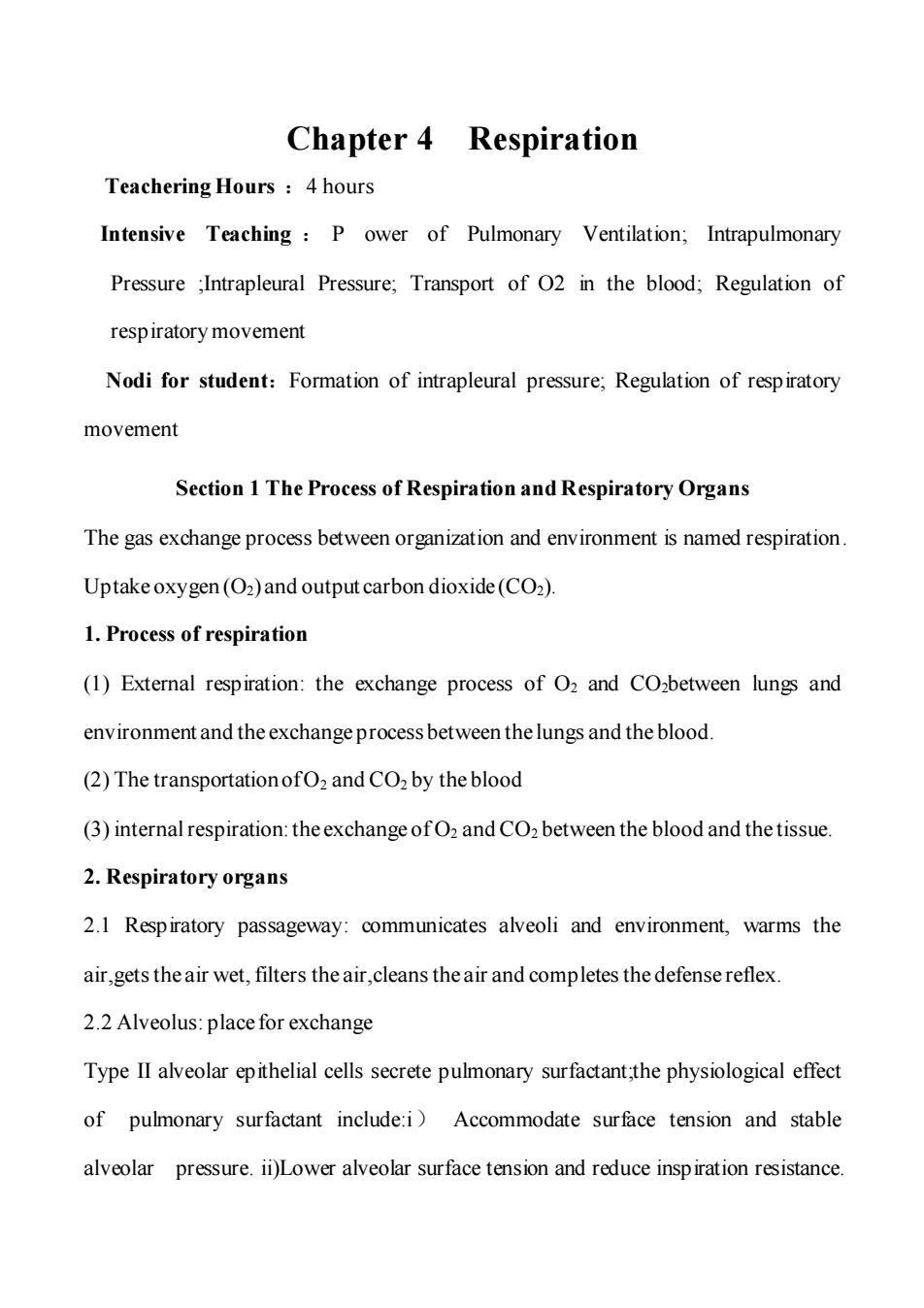
Chapter 4 Respiration Teachering Hours 4 hours Intensive Teaching P ower of Pulmonary Ventilation;Intrapulmonary Pressure Intrapleural Pressure;Transport of O2 in the blood;Regulation of respiratory movement Nodi for student:Formation of intrapleural pressure;Regulation of respiratory movement Section 1 The Process of Respiration and Respiratory Organs The gas exchange process between organization and environment is named respiration. Uptake oxygen(O2)and output carbon dioxide(CO2). 1.Process of respiration (1)External respiration:the exchange process of O2 and COzbetween lungs and environment and the exchange process between the lungs and the blood (2)The transportation ofO2 and CO2 by the blood (3)internal respiration:the exchange of O2 and CO2 between the blood and the tissue 2.Respiratory organs 2.1 Respiratory passageway:communicates alveoli and environment,warms the air,gets the air wet,filters the air,cleans the air and completes the defense reflex. 2.2 Alveolus:place for exchange Type II alveolar epithelial cells secrete pulmonary surfactant;the physiological effect of pulmonary surfactant include:i)Accommodate surface tension and stable alveolar pressure.ii)Lower alveolar surface tension and reduce insp iration resistance
Chapter 4 Respiration Teachering Hours :4 hours Intensive Teaching : P ower of Pulmonary Ventilation; Intrapulmonary Pressure ;Intrapleural Pressure; Transport of O2 in the blood; Regulation of respiratory movement Nodi for student:Formation of intrapleural pressure; Regulation of respiratory movement Section 1 The Process of Respiration and Respiratory Organs The gas exchange process between organization and environment is named respiration. Uptake oxygen (O2) and output carbon dioxide (CO2). 1. Process of respiration (1) External respiration: the exchange process of O2 and CO2between lungs and environment and the exchange process between the lungs and the blood. (2) The transportation of O2 and CO2 by the blood (3) internal respiration: the exchange of O2 and CO2 between the blood and the tissue. 2. Respiratory organs 2.1 Respiratory passageway: communicates alveoli and environment, warms the air,gets the air wet, filters the air,cleans the air and completes the defense reflex. 2.2 Alveolus: place for exchange Type II alveolar epithelial cells secrete pulmonary surfactant;the physiological effect of pulmonary surfactant include:i) Accommodate surface tension and stable alveolar pressure. ii)Lower alveolar surface tension and reduce inspiration resistance

iii)Reduce the producing of alveolar liquid and prevent pulmonary edema. Section 2 Pulmonary Ventilation Pulmonary ventilation is the gas exchange process between lungs and environment 1 respiratory movement:Thoracic expansion and contraction caused by respiratory muscles are named respiratory movement. Inspiration:inspiration muscles contractthoraxes expand lungs expand lung volumes increase intrapulmonary pressure decreases temporarily gas enters lungs Expiration:Expiration:diaphragm and external intercostal muscles relax lung recoils thorax recoils intrapulmonary pressure increases gas is removed 2 power of pulmonary ventilation (1)respiratory movement (2)intrapulmonary pressure (3)intrapleural pressure 3 Respiratory patterns: i)thoracic breathing i) abdominal breathing iii)thoracic-abdominal breathing 4 intrapulmonary pressure and intrapleural pressure 4.1 Intrapulmonary pressure Intrapulmonary pressure =atmospheric pressure At the last of inspiration and expiration Intrapulmonary pressure >atmospheric pressure expiration
iii)Reduce the producing of alveolar liquid and prevent pulmonary edema. Section 2 Pulmonary Ventilation Pulmonary ventilation is the gas exchange process between lungs and environment 1 respiratory movement: Thoracic expansion and contraction caused by respiratory muscles are named respiratory movement. Inspiration: inspiration muscles contract thoraxes expand lungs expand lung volumes increase intrapulmonary pressure decreases temporarily gas enters lungs Expiration: Expiration: diaphragm and external intercostal muscles relax lung recoils thorax recoils intrapulmonary pressure increases gas is removed. 2 power of pulmonary ventilation (1)respiratory movement (2) intrapulmonary pressure (3) intrapleural pressure 3 Respiratory patterns: i) thoracic breathing. ii) abdominal breathing iii)thoracic-abdominal breathing 4 intrapulmonary pressure and intrapleural pressure 4.1 Intrapulmonary pressure Intrapulmonary pressure =atmospheric pressure At the last of inspiration and expiration Intrapulmonary pressure >atmospheric pressure expiration
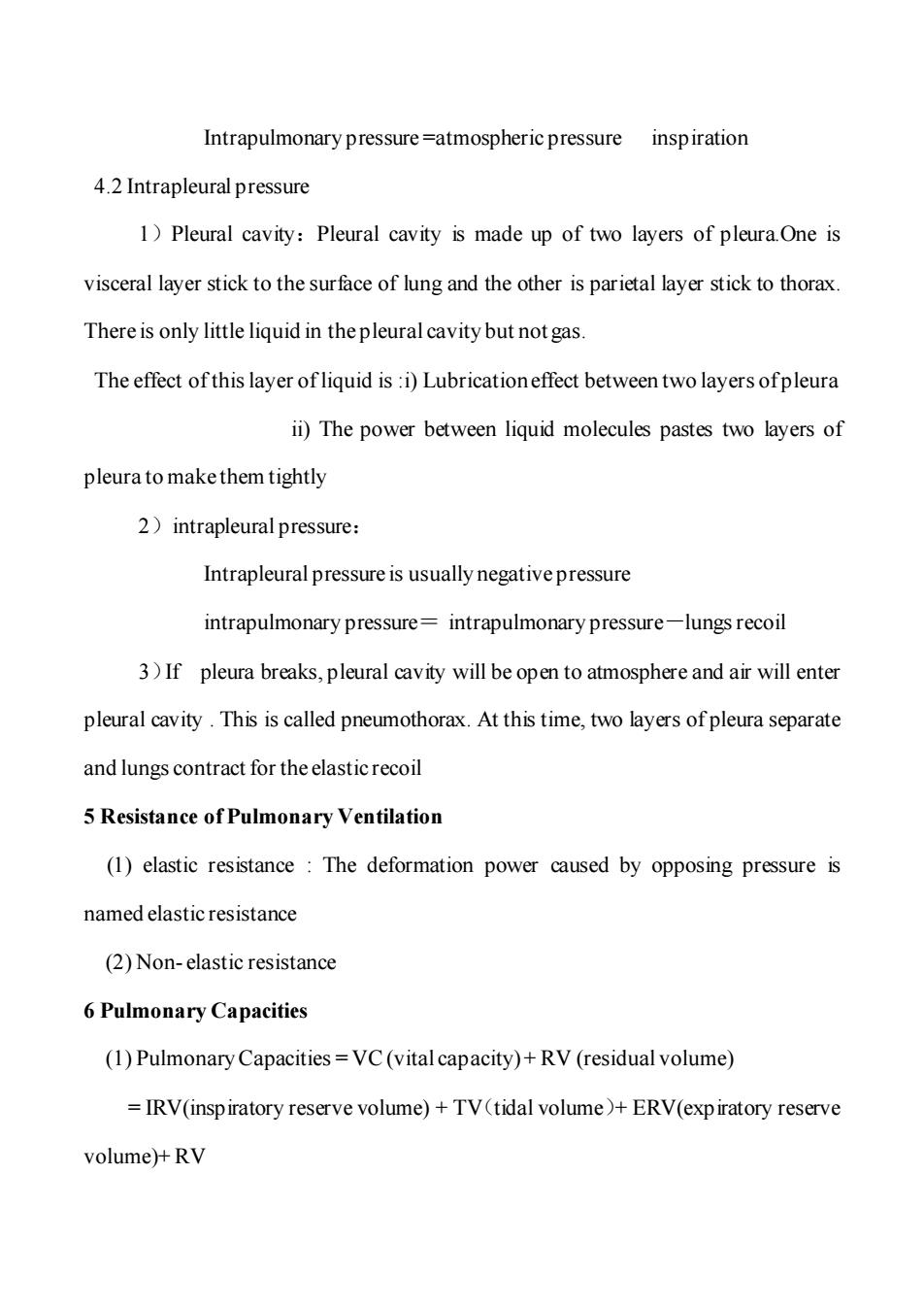
Intrapulmonary pressure=atmospheric pressure inspiration 4.2 Intrapleural pressure 1)Pleural cavity:Pleural cavity is made up of two layers of pleura.One is visceral layer stick to the surface of lung and the other is parietal layer stick to thorax. There is only little liquid in the pleural cavity but not gas. The effect of this layer of liquid is:i)Lubricationeffect between two layers ofpleura ii)The power between liquid molecules pastes two layers of pleura to make them tightly 2)intrapleural pressure: Intrapleural pressure is usually negative pressure intrapulmonary pressure=intrapulmonary pressure-lungs recoil 3)If pleura breaks,pleural cavity will be open to atmosphere and air will enter pleural cavity.This is called pneumothorax.At this time,two layers ofpleura separate and lungs contract for the elastic recoil 5 Resistance of Pulmonary Ventilation (1)elastic resistance The deformation power caused by opposing pressure is named elastic resistance (2)Non-elastic resistance 6 Pulmonary Capacities (1)Pulmonary Capacities=VC(vital capacity)+RV(residual volume) =IRV(inspiratory reserve volume)+TV(tidal volume)+ERV(expiratory reserve volume)+RV
Intrapulmonary pressure =atmospheric pressure inspiration 4.2 Intrapleural pressure 1)Pleural cavity:Pleural cavity is made up of two layers of pleura.One is visceral layer stick to the surface of lung and the other is parietal layer stick to thorax. There is only little liquid in the pleural cavity but not gas. The effect of this layer of liquid is :i) Lubrication effect between two layers of pleura ii) The power between liquid molecules pastes two layers of pleura to make them tightly 2)intrapleural pressure: Intrapleural pressure is usually negative pressure intrapulmonary pressure= intrapulmonary pressure-lungs recoil 3)If pleura breaks, pleural cavity will be open to atmosphere and air will enter pleural cavity . This is called pneumothorax. At this time, two layers of pleura separate and lungs contract for the elastic recoil 5 Resistance of Pulmonary Ventilation (1) elastic resistance : The deformation power caused by opposing pressure is named elastic resistance (2) Non- elastic resistance 6 Pulmonary Capacities (1) Pulmonary Capacities = VC (vital capacity) + RV (residual volume) = IRV(inspiratory reserve volume) + TV(tidal volume)+ ERV(expiratory reserve volume)+ RV
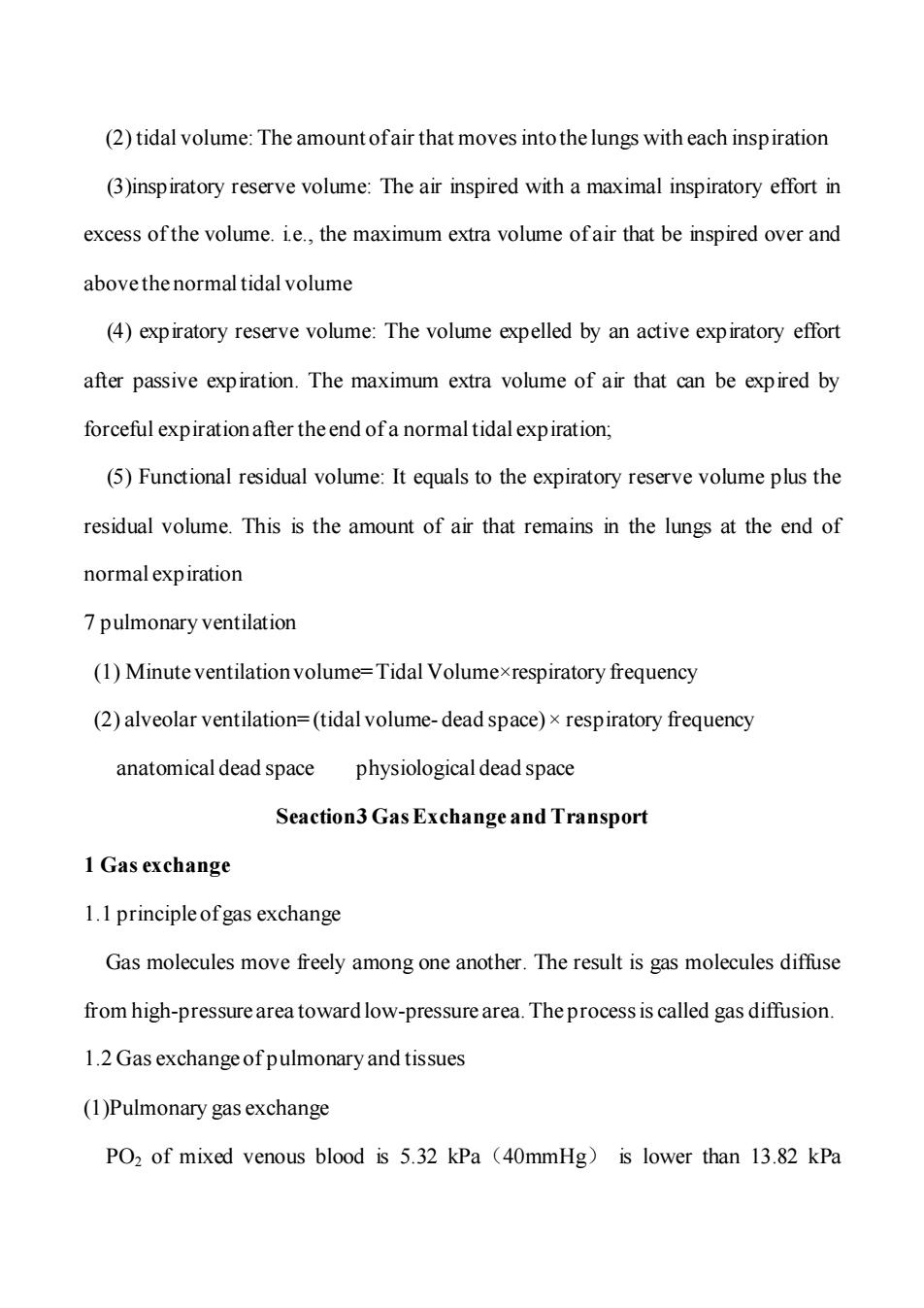
(2)tidal volume:The amount ofair that moves into the lungs with each inspiration (3)inspiratory reserve volume:The air inspired with a maximal inspiratory effort in excess of the volume.ie.,the maximum extra volume ofair that be inspired over and above the normal tidal volume (4)expiratory reserve volume:The volume expelled by an active expiratory effort after passive expiration.The maximum extra volume of air that can be expired by forceful expiration after the end ofa normal tidal expiration; (5)Functional residual volume:It equals to the expiratory reserve volume plus the residual volume.This is the amount of air that remains in the lungs at the end of normal expiration 7 pulmonary ventilation (1)Minute ventilation volume=Tidal Volumexrespiratory frequency (2)alveolar ventilation=(tidal volume-dead space)x respiratory frequency anatomical dead space physiological dead space Seaction3 Gas Exchange and Transport 1 Gas exchange 1.1 principle ofgas exchange Gas molecules move freely among one another.The result is gas molecules diffuse from high-pressure area toward low-pressure area.The process is called gas diffusion. 1.2 Gas exchange of pulmonary and tissues (1)Pulmonary gas exchange PO2 of mixed venous blood is 5.32 kPa (40mmHg)is lower than 13.82 kPa
(2) tidal volume: The amount of air that moves into the lungs with each inspiration (3)inspiratory reserve volume: The air inspired with a maximal inspiratory effort in excess of the volume. i.e., the maximum extra volume of air that be inspired over and above the normal tidal volume (4) expiratory reserve volume: The volume expelled by an active expiratory effort after passive expiration. The maximum extra volume of air that can be expired by forceful expiration after the end of a normal tidal expiration; (5) Functional residual volume: It equals to the expiratory reserve volume plus the residual volume. This is the amount of air that remains in the lungs at the end of normal expiration 7 pulmonary ventilation (1) Minute ventilation volume= Tidal Volume×respiratory frequency (2) alveolar ventilation= (tidal volume- dead space) × respiratory frequency anatomical dead space physiological dead space Seaction3 Gas Exchange and Transport 1 Gas exchange 1.1 principle of gas exchange Gas molecules move freely among one another. The result is gas molecules diffuse from high-pressure area toward low-pressure area. The process is called gas diffusion. 1.2 Gas exchange of pulmonary and tissues (1)Pulmonary gas exchange PO2 of mixed venous blood is 5.32 kPa(40mmHg) is lower than 13.82 kPa
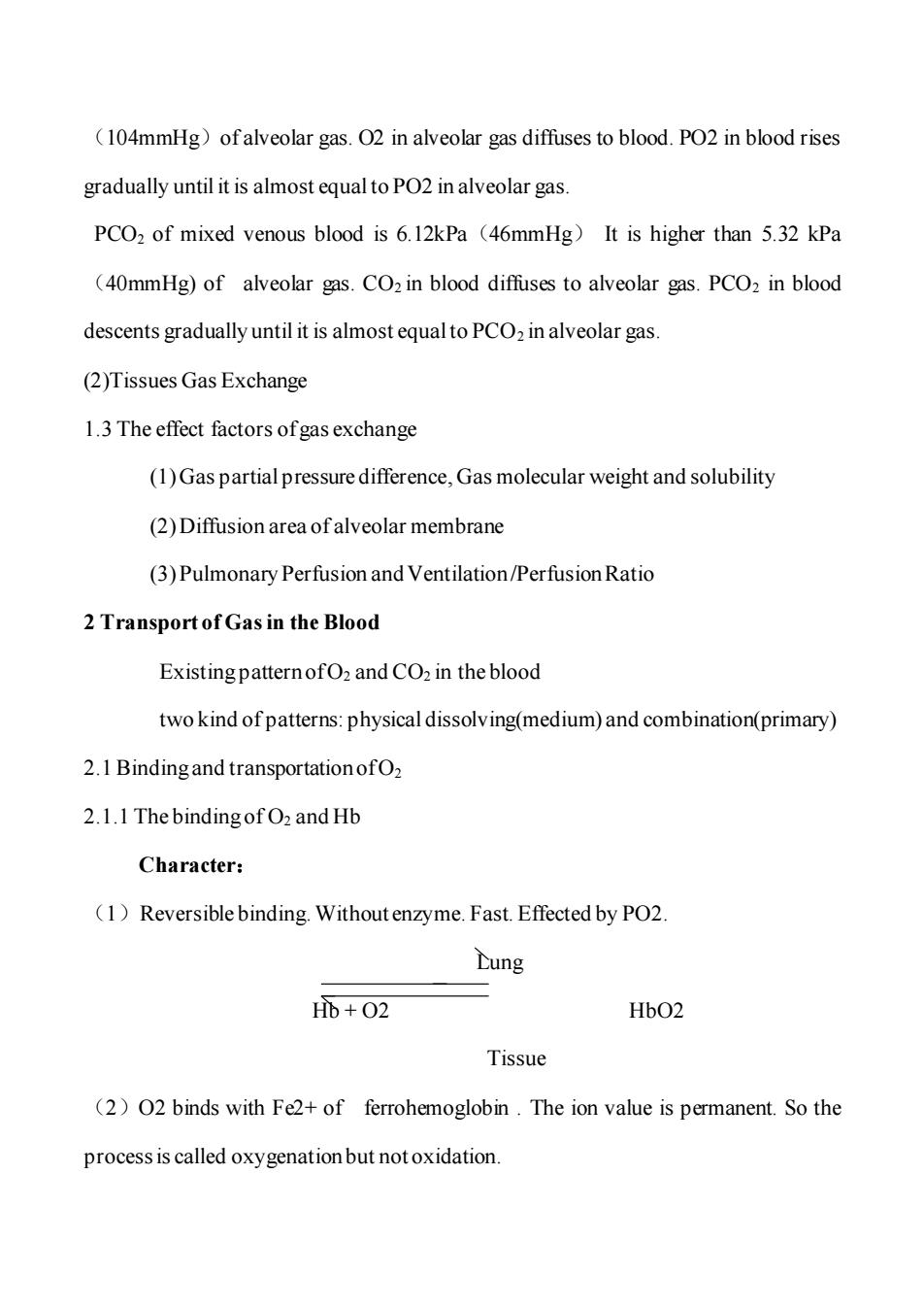
(104mmHg)ofalveolar gas.O2 in alveolar gas diffuses to blood.PO2 in blood rises gradually until it is almost equal to PO2 in alveolar gas. PCO2 of mixed venous blood is 6.12kPa (46mmHg)It is higher than 5.32 kPa (40mmHg)of alveolar gas.CO2 in blood diffuses to alveolar gas.PCO2 in blood descents gradually until it is almost equal to PCO2 in alveolar gas. (2)Tissues Gas Exchange 1.3 The effect factors ofgas exchange (1)Gas partial pressure difference,Gas molecular weight and solubility (2)Diffusion area of alveolar membrane (3)Pulmonary Perfusion and Ventilation/Perfusion Ratio 2 Transport of Gas in the Blood Existing pattern ofO2 and CO2 in the blood two kind of patterns:physical dissolving(medium)and combination(primary) 2.1 Binding and transportationofO2 2.1.1 The binding of O2 and Hb Character: (1)Reversible binding.Withoutenzyme.Fast.Effected by PO2. Lung ib+02 HbO2 Tissue (2)O2 binds with Fe2+of ferrohemoglobin.The ion value is permanent.So the process is called oxy genation but not oxidation
(104mmHg)of alveolar gas. O2 in alveolar gas diffuses to blood. PO2 in blood rises gradually until it is almost equal to PO2 in alveolar gas. PCO2 of mixed venous blood is 6.12kPa(46mmHg) It is higher than 5.32 kPa (40mmHg) of alveolar gas. CO2 in blood diffuses to alveolar gas. PCO2 in blood descents gradually until it is almost equal to PCO2 in alveolar gas. (2)Tissues Gas Exchange 1.3 The effect factors of gas exchange (1)Gas partial pressure difference, Gas molecular weight and solubility (2) Diffusion area of alveolar membrane (3) Pulmonary Perfusion and Ventilation /Perfusion Ratio 2 Transport of Gas in the Blood Existing pattern of O2 and CO2 in the blood two kind of patterns: physical dissolving(medium) and combination(primary) 2.1 Binding and transportation of O2 2.1.1 The binding of O2 and Hb Character: (1)Reversible binding. Without enzyme. Fast. Effected by PO2. Lung Hb + O2 HbO2 Tissue (2)O2 binds with Fe2+ of ferrohemoglobin . The ion value is permanent. So the process is called oxygenation but not oxidation
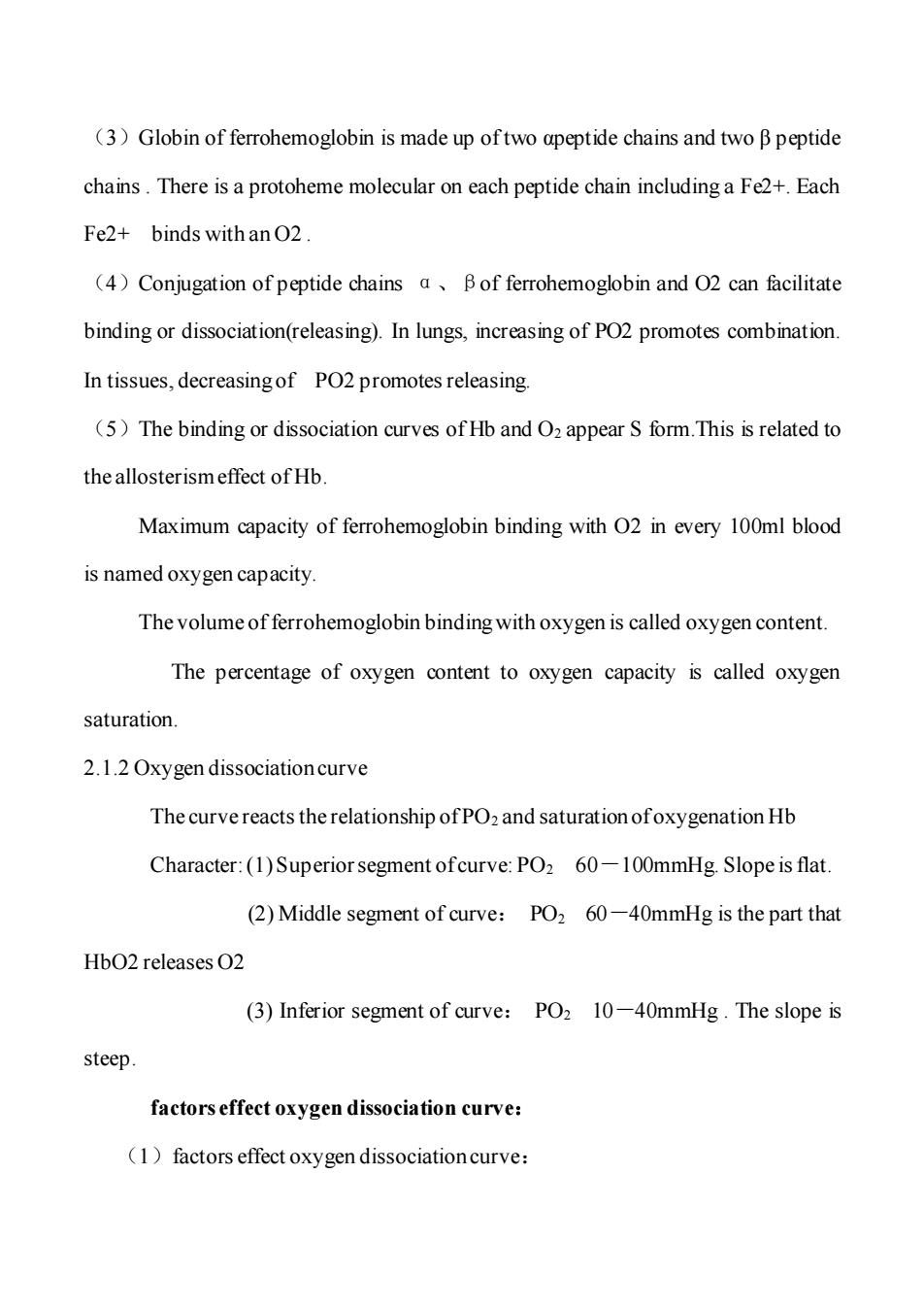
(3)Globin of ferrohemoglobin is made up of two apeptide chains and two B peptide chains.There is a protoheme molecular on each peptide chain including a Fe2+.Each Fe2+binds with an O2. (4)Conjugation of peptide chains a B of ferrohemoglobin and O2 can facilitate binding or dissociation(releasing).In lungs,increasing of PO2 promotes combination. In tissues,decreasing of PO2 promotes releasing (5)The binding or dissociation curves of Hb and O2 appear S form.This is related to the allosterism effect of Hb. Maximum capacity of ferrohemoglobin binding with O2 in every 100ml blood is named oxygen capacity. The volume of ferrohemoglobin binding with oxygen is called oxygen content. The percentage of oxygen content to oxygen capacity is called oxygen saturation. 2.1.2 Oxygen dissociationcurve The curve reacts the relationship of PO2 and saturation ofoxygenation Hb Character:(1)Superior segment ofcurve:PO2 60-100mmHg.Slope is flat. (2)Middle segment of curve:PO2 60-40mmHg is the part that HbO2 releases O2 (3)Inferior segment of curve:PO2 10-40mmHg.The slope is steep. factors effect oxygen dissociation curve: (1)factors effect oxygen dissociation curve:
(3)Globin of ferrohemoglobin is made up of two αpeptide chains and two β peptide chains . There is a protoheme molecular on each peptide chain including a Fe2+. Each Fe2+ binds with an O2 . (4)Conjugation of peptide chains α、βof ferrohemoglobin and O2 can facilitate binding or dissociation(releasing). In lungs, increasing of PO2 promotes combination. In tissues, decreasing of PO2 promotes releasing. (5)The binding or dissociation curves of Hb and O2 appear S form.This is related to the allosterism effect of Hb. Maximum capacity of ferrohemoglobin binding with O2 in every 100ml blood is named oxygen capacity. The volume of ferrohemoglobin binding with oxygen is called oxygen content. The percentage of oxygen content to oxygen capacity is called oxygen saturation. 2.1.2 Oxygen dissociation curve The curve reacts the relationship of PO2 and saturation of oxygenation Hb Character: (1) Superior segment of curve: PO2 60-100mmHg. Slope is flat. (2) Middle segment of curve: PO2 60-40mmHg is the part that HbO2 releases O2 (3) Inferior segment of curve: PO2 10-40mmHg . The slope is steep. factors effect oxygen dissociation curve: (1)factors effect oxygen dissociation curve:
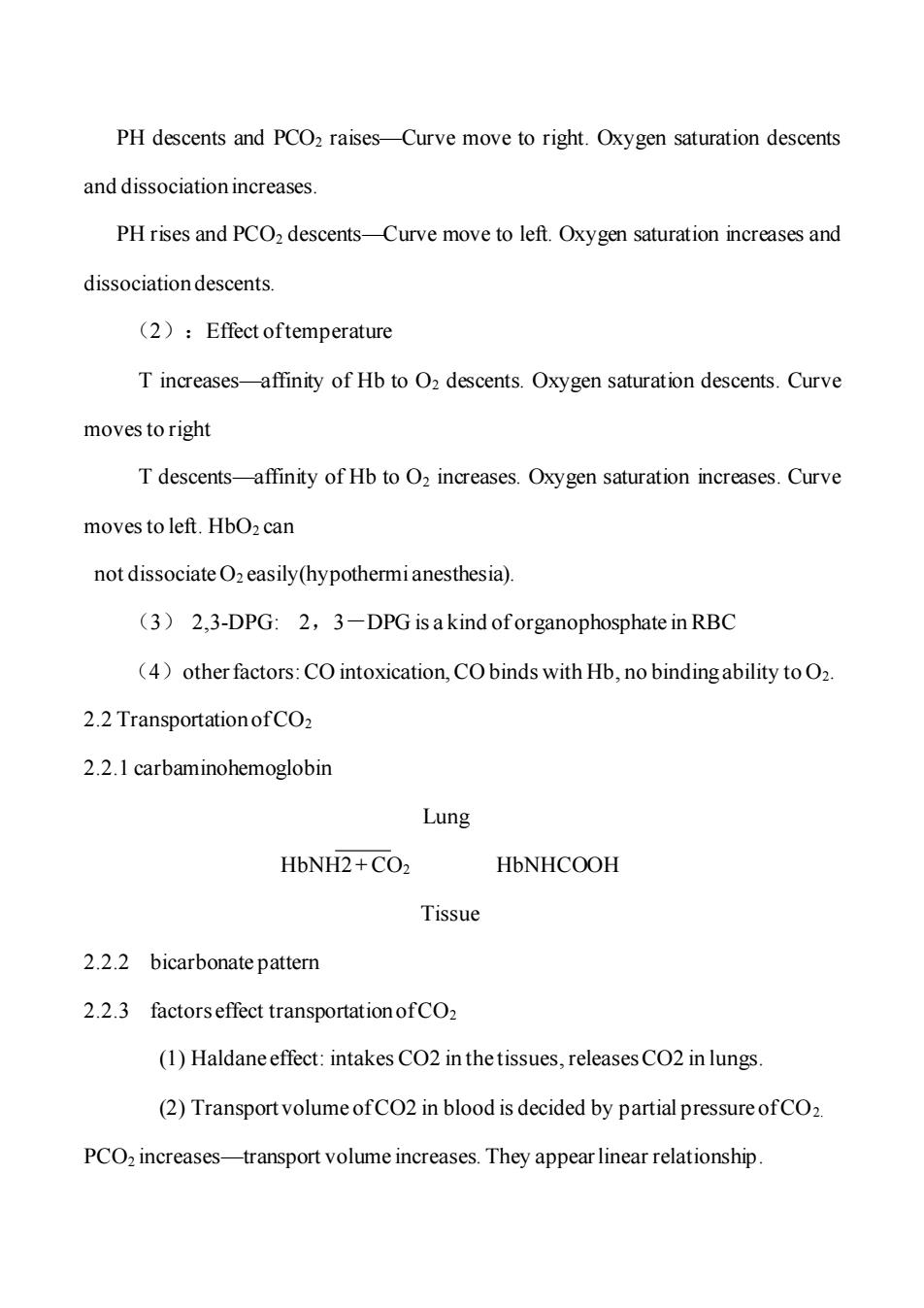
PH descents and PCO2 raises-Curve move to right.Oxygen saturation descents and dissociation increases. PH rises and PCO2 descents-Curve move to left.Oxygen saturation increases and dissociation descents. (2):Effect oftemperature T increases-affinity of Hb to O2 descents.Oxygen saturation descents.Curve moves to right T descents-affinity of Hb to O2 increases.Oxygen saturation increases.Curve moves to left.HbO2 can not dissociate O2 easily(hypothermi anesthesia) (3)2,3-DPG:2,3-DPG is a kind oforganophosphate in RBC (4)other factors:CO intoxication,CO binds with Hb,no bindingability to O2 2.2 Transportation ofCO2 2.2.1 carbaminohemoglobin Lung HbNH2+CO2 HbNHCOOH Tissue 2.2.2 bicarbonate pattern 2.2.3 factors effect transportation ofCO2 (1)Haldane effect:intakes CO2 in thetissues,releases CO2 in lungs. (2)Transport volume ofCO2 in blood is decided by partial pressureofCO2. PCO2 increases-transport volume increases.They appear linear relationship
PH descents and PCO2 raises—Curve move to right. Oxygen saturation descents and dissociation increases. PH rises and PCO2 descents—Curve move to left. Oxygen saturation increases and dissociation descents. (2):Effect of temperature T increases—affinity of Hb to O2 descents. Oxygen saturation descents. Curve moves to right T descents—affinity of Hb to O2 increases. Oxygen saturation increases. Curve moves to left. HbO2 can not dissociate O2 easily(hypothermi anesthesia). (3) 2,3-DPG: 2,3-DPG is a kind of organophosphate in RBC (4)other factors:CO intoxication, CO binds with Hb, no binding ability to O2. 2.2 Transportation of CO2 2.2.1 carbaminohemoglobin Lung HbNH2 + CO2 HbNHCOOH Tissue 2.2.2 bicarbonate pattern 2.2.3 factors effect transportation of CO2 (1) Haldane effect: intakes CO2 in the tissues, releases CO2 in lungs. (2) Transport volume of CO2 in blood is decided by partial pressure of CO2. PCO2 increases—transport volume increases. They appear linear relationship

Seaction 4 Regulation of respiratory movement 1 Formation of respiratory center and respiratory rhythm 1.1 respiratory center Superior part ofpons--Pneumotaxic center medulla oblongata--basical respiratory center spinal cord--primary respiratory center pones respiratory center 1.2 Formation of Respiratory Rhythm: Reversion inhibition themry(part neuronal circuit feedback and controling themry) (1)Central inspiratory activity:Ianeur is probably the source of central inspiratory activity. (2)inspiratory off-switch mechanism inspiration-initiative process,expiration-passive-process 2 Reflectivity Regulation of Reflective Movement 2.1 Pulmonary stretchreflex(Hering-Breuer reflex) Lobe oflung expands-inhibits inspiration Lobe of lung diminish strongly-inhibit respiration Significance (1)Urge inspiration change into expiration promptly,inhibit too deep or too long inspiration. (2)urge expiration change into inspiration promptly,inhibit too
Seaction 4 Regulation of respiratory movement 1 Formation of respiratory center and respiratory rhythm 1.1 respiratory center Superior part of pons --Pneumotaxic center medulla oblongata--basical respiratory center spinal cord--primary respiratory center pones respiratory center 1.2 Formation of Respiratory Rhythm: Reversion inhibition themry(part neuronal circuit feedback and controling themry) (1) Central inspiratory activity: Iαneur is probably the source of central inspiratory activity. (2) inspiratory off-switch mechanism inspiration-initiative process, expiration-passive -process 2 Reflectivity Regulation of Reflective Movement 2.1 Pulmonary stretch reflex (Hering-Breuer reflex) Lobe of lung expands—inhibits inspiration Lobe of lung diminish strongly—inhibit respiration Significance: (1)Urge inspiration change into expiration promptly,inhibit too deep or too long inspiration. (2)urge expiration change into inspiration promptly, inhibit too

expiration. 2.2 The reflex ofrespirationmuscle propriocepto Significance:when respiration muscle is passively stretched of isometric contract,it can be contracted and strengthened reflexly through respiration muscle propriocepto.It is profitable to overcome the resistance and sustain the normal gas volume ofrespiration. 3 Humoral regulation of respiratory 3.1 peripheral chemoreceptor: Carotid body and aortic body:stimulated when PCO2 in blood increases,PO2 in blood decrease,H+Concentration in blood increase. 3.2 Influence of CO2 to respiration (1 Act indirectly to central chemoreceptor(main pathway) (2)Act directly to peripheral chemoreceptor 3.3 Effect of O2 to respiration The main pathway is acting directly on peripheral chemoreceptor and inputting impulse.respiration center is excited. (1)Hypoxia stimulation act through peripheral chemoreceptor.if the inputing of peripheral chemoreceptor is cut,the stimulation effect disappear. (2)The direct effect of hypoxia to center is light inhibition. (3)Mild hypoxia (PO2>80mmHg)has no obviouseffect to respiration. 3.4 Effect of H+to respiration (1)Increasing H+or decreasing PH can faster respiration.It is the effective
expiration. 2.2 The reflex of respiration muscle propriocepto Significance: when respiration muscle is passively stretched of isometric contract, it can be contracted and strengthened reflexly through respiration muscle propriocepto. It is profitable to overcome the resistance and sustain the normal gas volume of respiration. 3 Humoral regulation of respiratory 3.1 peripheral chemoreceptor: Carotid body and aortic body: stimulated when PCO2 in blood increases, PO2 in blood decrease, H+ Concentration in blood increase. 3.2 Influence of CO2 to respiration (1)Act indirectly to central chemoreceptor(main pathway) (2)Act directly to peripheral chemoreceptor 3.3 Effect of O2 to respiration The main pathway is acting directly on peripheral chemoreceptor and inputting impulse.respiration center is excited. (1) Hypoxia stimulation act through peripheral chemoreceptor.if the inputing of peripheral chemoreceptor is cut, the stimulation effect disappear. (2) The direct effect of hypoxia to center is light inhibition. (3) Mild hypoxia (PO2>80mmHg)has no obvious effect to respiration. 3.4 Effect of H+ to respiration (1) Increasing H+ or decreasing PH can faster respiration. It is the effective

stimulator to chemoreceptor. (2)Pathway of H+regulating respiration:A)H+in blood increases-excites peripheral chemoreceptor mainly;B)H+in Spinal Fluid increases--excites central chemoreceptor
stimulator to chemoreceptor. (2) Pathway of H+ regulating respiration:A) H+ in blood increases—excites peripheral chemoreceptor mainly;B) H+ in Spinal Fluid increases-- excites central chemoreceptor